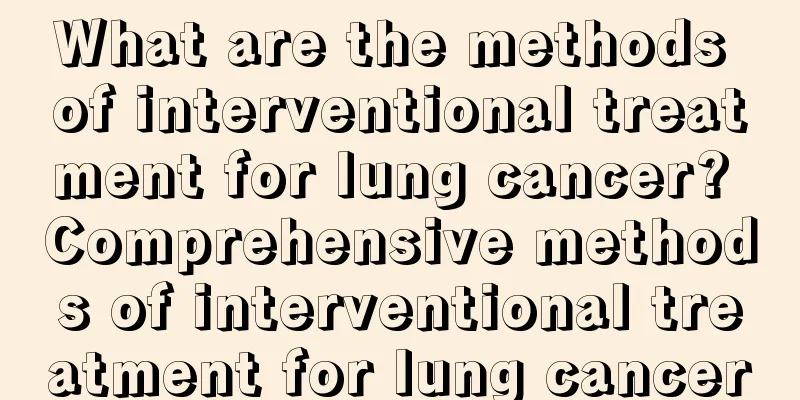What are the methods of interventional treatment for lung cancer? Comprehensive methods of interventional treatment for lung cancer

|
Lung cancer is one of the most common systemic malignant tumors, which seriously threatens human health and life. Its causes and mechanisms are not yet fully understood. At present, the treatment of lung cancer is still a comprehensive treatment with surgery as the main method. However, based on the biological characteristics of lung cancer cells and the non-specific clinical manifestations of lung cancer, about 3/4 of lung cancer patients are already in the middle and late stages when diagnosed, and lose the opportunity for surgery. The adverse reactions caused by simple radiotherapy and chemotherapy are relatively large. Therefore, interventional treatment of lung cancer came into being. The following is a brief introduction to several interventional treatment methods for lung cancer: 1. Intravascular Intervention 1. Pulmonary artery infusion chemotherapy (pAI): pAI not only acts directly on the local tumor, but also can reach the lymph nodes in the hilum, mediastinum, etc., which is very beneficial to the patient's prognosis. 2. Interventional treatment with floating catheter placement in the pulmonary artery: This method has definite efficacy, less pain for patients and low cost, but there are problems such as catheter displacement, drug box flipping or chemotherapy drug blockage, which makes it impossible for the floating catheter to remain in the body for a long time. 3. Subcutaneous drug box implantation system chemotherapy: This method avoids the shortcomings of repeated puncture and intubation, irregular treatment, and hasty injection time. It can be injected regularly and repeatedly, and is a permanent or semi-permanent route of drug administration. 2. Non-vascular interventional therapy 1. Laser therapy: Currently, the lasers used to treat lung cancer are mainly carbon dioxide laser and neodymium-doped yttrium aluminum garnet (Nd-YAG) laser. Laser can convert light radiation energy into cutting, gasification and coagulation, resulting in cell structure destruction and separation of tissue layers. 2. Argon-helium cryotherapy: Argon-helium cryotherapy works by rapidly cooling tissue cells, freezing them, and thawing and rewarming them. Argon-helium cryotherapy is effective in controlling local tumors, and can be effectively combined with other local and systemic treatments to improve long-term efficacy. 3. Percutaneous pulmonary puncture intratumoral anhydrous alcohol injection (pEI): This is a commonly used method for treating solid tumors. Anhydrous alcohol is injected into the tumor to directly act on tumor cells, causing them to coagulate, degenerate, and necrotize. The efficacy of pEI alone for lung cancer is limited, and it is currently used in combination with BAI. 4. Percutaneous lung puncture and intratumoral injection of local chemotherapy: After puncturing into the solid tumor under the guidance of CT or B-ultrasound, chemotherapy drugs are injected locally, and the tumor is directly killed by the diffusion of local high-concentration chemotherapy drugs. This method is more effective for peripheral lung cancer with a diameter of <2cm. However, the drug is easily blocked by the fiber partition inside the diseased tissue, which limits the diffusion range and affects the efficacy. 3. Percutaneous CT-guided radioactive particle implantation: This method uses radioactive particles to continuously irradiate the local tumor with low-dose radiation to directly inhibit the mitosis of tumor cells. Since the particle radioactivity is small, the local tumor irradiation lasts for a long time, the killing power to tumor cells is strong, and the dose outside the tumor range is sharply reduced, which reduces the damage to the surrounding normal tissues and can preserve the lung function to the maximum extent. |
>>: Why do liver cancer patients sweat? How can liver cancer patients with sweating be solved?
Recommend
Weight gain and fitness diet plan
In today's society, fat people have trouble l...
What are the sequelae of radiotherapy for advanced nasopharyngeal carcinoma and what are the symptoms?
What are the sequelae of radiotherapy for advance...
How to restore the clothes if they are snagged
When the weather turns cooler, everyone will wear...
There is a bump on the heel
The feet are a part of our body and their main fu...
Where is the nasal septum
The nasal septum is a key part of the human body....
What is the reason for thick saliva? Be careful about this!
Many people are prone to dry mouth. In addition, ...
What to do about congenital malnutrition?
Congenital malnutrition is a phenomenon that many...
What are some tips for preventing pituitary tumors
Everyone is familiar with pituitary tumors. Many ...
What are the causes of prostate cancer?
The causes of prostate cancer are relatively comp...
Specific medicine for ankylosing spondylitis
Nowadays, most people spend a long time looking a...
Crab and dragon fruit
Everyone knows that crabs are very cold foods, so...
What are the dangers of long-term uncured fibroids?
Many patients with fibroids know that most fibroi...
How to eat coix seed to remove spots?
Facial spots have always been a skin problem that...
Diet therapy is the key to the treatment of ulcerative proctitis
If you suffer from proctitis and develop ulcers, ...
What are the ways gastric cancer metastasizes? Pay attention to these
The main ways of gastric cancer metastasis includ...









